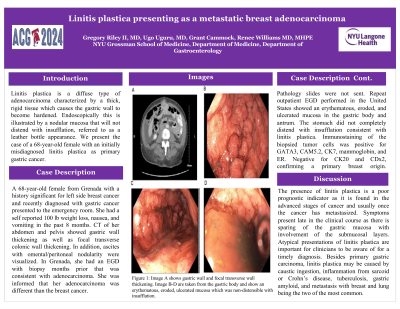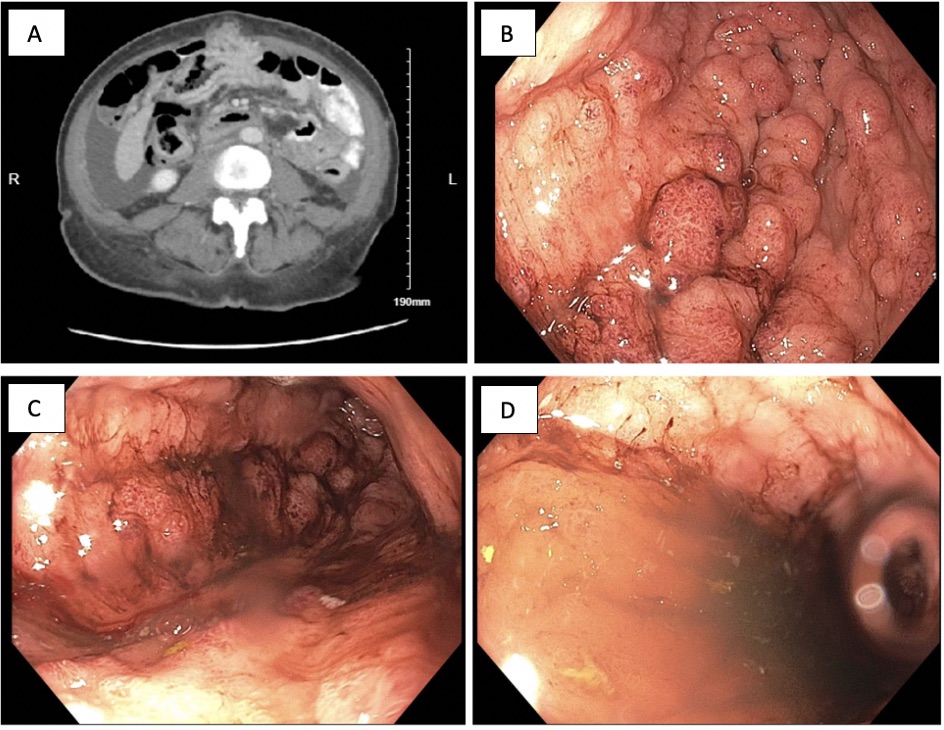Monday Poster Session
Category: Stomach
P3342 - Metastatic Breast Adenocarcinoma Presenting as Linitis Plastica
Monday, October 28, 2024
10:30 AM - 4:00 PM ET
Location: Exhibit Hall E

Has Audio
- GR
Gregory Riley, II, MD
NYU Grossman School of Medicine
New York, NY
Presenting Author(s)
Gregory Riley, MD1, Ugo Uguru, MD2, Renee Williams, MD3, Grant Cammock, BS1
1NYU Grossman School of Medicine, New York, NY; 2New York University Langone Health, New York, NY; 3NYU Grossman School of Medicine, North Bergen, NJ
Introduction: Linitis plastica is a diffuse type of adenocarcinoma characterized by thick, rigid tissue which causes the gastric wall to become hardened. Endoscopically this is illustrated by a nodular mucosa that will not distend with insufflation, referred to as a leather bottle appearance. We present the case of a 68-year-old female with an initially misdiagnosed linitis plastica as primary gastric cancer.
Case Description/Methods: A 68-year-old female from Grenada with a history significant for left sided breast cancer (s/p mastectomy in 2020) and recently diagnosed gastric cancer in Grenada presented to the emergency room to establish care. Interview was significant for a self-reported 100 lb weight loss in 8 months, nausea, and decreased appetite. On physical examination she was a chronically ill-appearing. Laboratory analysis was insignificant. Computed tomography (CT) of the abdomen and pelvis showed gastric wall thickening as well as focal transverse colonic wall thickening (Image A). In addition, ascites with omental/peritoneal nodularity were visualized. In Grenada, she had an EGD with biopsy a few months prior that was diagnosed as gastric adenocarcinoma. She was informed that her adenocarcinoma was different than the breast cancer. Pathology slides were not sent. Repeat EGD was performed in the United States with an erythematous, eroded, and ulcerated mucosa in the gastric body and antrum. The stomach did not completely distend with insufflation consistent endoscopically with linitis plastica (Images B-D). Immunostaining of the biopsied tumor cells was +GATA3, +CAM5.2, +CK7, +mammaglobin and +ER, -CK20 and -CDX2. Confirming primary breast origin.
Discussion: The presence of linitis plastica is a poor prognostic indicator as it is found in the advanced stages of cancer and usually once the cancer has metastasized. Symptoms present late in the clinical course as there is sparing of the gastric mucosa with involvement of the submucosal and muscular layers. Atypical presentations of linitis plastica are important for clinicians to be aware of for a timely diagnosis. Besides primary gastric carcinoma, linitis plastica may be caused by caustic ingestion, inflammation from sarcoid, Crohn’s disease or tuberculosis, gastric amyloid, and metastasis, with breast and lung being two of the most common.

Disclosures:
Gregory Riley, MD1, Ugo Uguru, MD2, Renee Williams, MD3, Grant Cammock, BS1. P3342 - Metastatic Breast Adenocarcinoma Presenting as Linitis Plastica, ACG 2024 Annual Scientific Meeting Abstracts. Philadelphia, PA: American College of Gastroenterology.
1NYU Grossman School of Medicine, New York, NY; 2New York University Langone Health, New York, NY; 3NYU Grossman School of Medicine, North Bergen, NJ
Introduction: Linitis plastica is a diffuse type of adenocarcinoma characterized by thick, rigid tissue which causes the gastric wall to become hardened. Endoscopically this is illustrated by a nodular mucosa that will not distend with insufflation, referred to as a leather bottle appearance. We present the case of a 68-year-old female with an initially misdiagnosed linitis plastica as primary gastric cancer.
Case Description/Methods: A 68-year-old female from Grenada with a history significant for left sided breast cancer (s/p mastectomy in 2020) and recently diagnosed gastric cancer in Grenada presented to the emergency room to establish care. Interview was significant for a self-reported 100 lb weight loss in 8 months, nausea, and decreased appetite. On physical examination she was a chronically ill-appearing. Laboratory analysis was insignificant. Computed tomography (CT) of the abdomen and pelvis showed gastric wall thickening as well as focal transverse colonic wall thickening (Image A). In addition, ascites with omental/peritoneal nodularity were visualized. In Grenada, she had an EGD with biopsy a few months prior that was diagnosed as gastric adenocarcinoma. She was informed that her adenocarcinoma was different than the breast cancer. Pathology slides were not sent. Repeat EGD was performed in the United States with an erythematous, eroded, and ulcerated mucosa in the gastric body and antrum. The stomach did not completely distend with insufflation consistent endoscopically with linitis plastica (Images B-D). Immunostaining of the biopsied tumor cells was +GATA3, +CAM5.2, +CK7, +mammaglobin and +ER, -CK20 and -CDX2. Confirming primary breast origin.
Discussion: The presence of linitis plastica is a poor prognostic indicator as it is found in the advanced stages of cancer and usually once the cancer has metastasized. Symptoms present late in the clinical course as there is sparing of the gastric mucosa with involvement of the submucosal and muscular layers. Atypical presentations of linitis plastica are important for clinicians to be aware of for a timely diagnosis. Besides primary gastric carcinoma, linitis plastica may be caused by caustic ingestion, inflammation from sarcoid, Crohn’s disease or tuberculosis, gastric amyloid, and metastasis, with breast and lung being two of the most common.

Figure: Image A shows gastric wall and focal transverse wall thickening. Images B-D are taken from the gastric body and show an erythematous, eroded and ulcerated mucosa which was non-distensible with insufflation.
Disclosures:
Gregory Riley indicated no relevant financial relationships.
Ugo Uguru indicated no relevant financial relationships.
Renee Williams: Medtronic – Consultant. Olympus USA – Consultant. Universal Dx – Consultant.
Grant Cammock indicated no relevant financial relationships.
Gregory Riley, MD1, Ugo Uguru, MD2, Renee Williams, MD3, Grant Cammock, BS1. P3342 - Metastatic Breast Adenocarcinoma Presenting as Linitis Plastica, ACG 2024 Annual Scientific Meeting Abstracts. Philadelphia, PA: American College of Gastroenterology.
